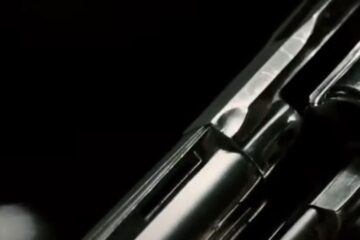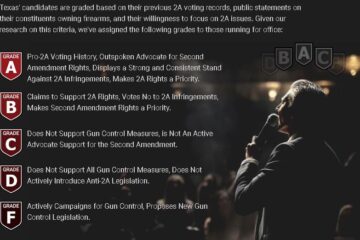Defensive Ammunition Optimized: Federal’s 30 Super Carry
The last widely popular pistol cartridge intended specifically for concealed carry was the .380 ACP, designed more than 100 years ago by John Moses Browning for the 1908 Colt pistol. I have often looked with mild frustration at the .380 and the ubiquitous 9 mm Luger, our two most common “carry” pistol cartridges. Why? Because now, more than a century removed from their inception, there remain pressure or performance limitations that it seems we should be able to overcome with such carry-size handgun cartridges. The engineers at Federal apparently agreed, and, seeing an opportunity in the performance gap between these two mainstays, they went to work. The 30 Super Carry is the resulting cartridge, and, as the name suggests, it is aimed squarely at the concealed-carry market.
Up Front
The 30 Super Carry is a high-performance, concealed-carry cartridge launching heavy-for-caliber 100- and 115-grain bullets of 0.312″ diameter at 1,150 to 1,250 f.p.s. Federal’s goal was to close the substantial gap between .380 ACP and 9 mm Luger—both of which feature 0.355″-diameter bullets. But, at the risk of giving away the ending up front, the Super Carry nearly meets the terminal performance of best-in-class, standard-pressure 9 mm Luger loads while dramatically outperforming similar .380 ACP loads. The icing on the cake is that most pistol designs will gain two rounds of capacity in their magazines when chambered for the smaller-diameter Super Carry cartridge. While two may not seem to be a significant number, in the world of concealed carry, it can easily translate to a 20- to 30-percent increase in onboard capacity. In addition, the engineering that must be accomplished to achieve such increases in existing platforms is not without difficulty. That’s one reason why major new pistol cartridge introductions are relatively unusual events. In the rifle world, it seems that new cartridges or fresh takes on a popular bore size occur almost annually, but the handgun world is rather conservative. There are shooters entering the market who haven’t seen a major new semi-automatic cartridge of any type in their lifetimes. In fact, quite the opposite; in the past few years, a half-dozen once-popular cartridges have faded toward obsolescence. Federal is celebrating its 100th anniversary this year, and when the first Federal ammunition was made a century ago, the .380 ACP and 9 mm Luger cartridges were both already well-established. We truly are due for some fresh thinking and options. Enter 30 Super Carry.

- Activate Your Own Stem Cells & Reverse The Aging Process - Choose "Select & Save" OR Join, Brand Partner & Select Silver To Get Wholesale Prices
- Get your Vitamin B17 & Get 10% Off With Promo Code TIM
- How To Protect Yourself From 5G, EMF & RF Radiation
- Protect Your Income & Retirement Assets With Gold & Silver
- Grab This Bucket Of Heirloom Seeds & Get Free Shipping With Promo Code TIM
- Here’s A Way You Can Stockpile Food For The Future
- Stockpile Your Ammo & Save $15 On Your First Order
- Preparing Also Means Detoxifying – Here’s One Simple Way To Detoxify
Background & Testing
It is remarkable that the Super Carry is being launched years into a historic ammunition shortage. Two points bear on this. First, there is a historic surge of new shooters entering the market who are primarily interested in concealed carry or personal defense—the very market for which 30 Super Carry is designed. The time to get those shooters choosing the new cartridge is now. The second point is that Federal is innovating from a position of strength, and it does demonstrate a certain confidence in the new cartridge. Fairly or not, many of us look somewhat suspiciously at new products launched in a slump following a post-panic recovery as perhaps an attempt to energize sales rather than initiate real innovation.
Whereas the .380 ACP was designed around the pressure limitations of early blowback-operated pistols, the 30 Super Carry was designed to meet a modern set of performance requirements. Federal wanted to achieve as near to 9 mm Luger-level terminal ballistics as possible in a carry-friendly package. The engineers observed that the typical armed citizen is primarily concerned with adequate expansion and penetration in a defensive encounter and does not have to contend with barrier penetration (walls, auto bodies and windshields) the same way that law-enforcement officers do. It is barrier penetration that tends to confound most “back-up gun” cartridges and loadings, so Federal zeroed-in on the performance best measured by the standardized FBI testing of bare calibrated ordnance gelatin and heavy-clothing-clad gel.
The definition of effective in gelatin testing is typically for a projectile to expand at least one-and-a-half times its starting diameter and to penetrate at least 12″. The ammunition makers have made great strides in recent years in more reliably achieving this with their premium defensive loads from subcompact 9 mm Luger-chambered semi-automatics, but it is still the exception for a .380 ACP load to penetrate to more than 12″ while expanding. It is for this reason that many major law-enforcement organizations prohibit .380 ACP for off-duty or backup carry.
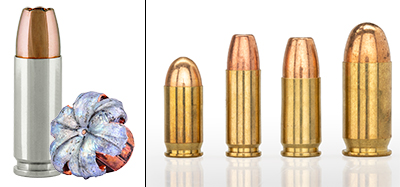
Federal felt it had learned a considerable amount during the development of the HST Deep line and other recent products and was able to translate and even further exploit that knowledge in the development of 30 Super Carry. The result is projectiles that are upsetting (mushrooming in the shooter’s vernacular) to 0.50″ or more and reaching 15″ of penetration, even after passing through heavy clothing.
Federal’s testing further suggests very consistent performance in short barrels in which the bullets reliably expand between 0.50″ and 0.59″ and drive 12″ to 15″, depending on the load and whether penetrating bare or heavy-clothing-layered gelatin. This would be excellent performance from most 9 mm Luger loads on the market when fired from the stubby-barreled micro pistols. Looking at recovered Super Carry projectiles, they are indistinguishable from expanded 9 mm Luger bullets until one flips the bullet over and notices the smaller 0.312″-diameter base.
If a shooter is interested in muzzle energy as a means of comparison, the Super Carry is right there in traditional 9 mm territory, as evidenced by Federal’s test numbers found at the bottom-left of p. 54. That is not surprising given that the 30 Super Carry is pushing bullets of similar weights to velocities similar to those of common 9 mm loadings. The HST, Gold Dot and Remington HTP loads bracket 336 to 347 ft.-lbs. of muzzle energy, whereas 9 mm Luger HST loads generate between 270 and 396 ft.-lbs.

Personal Experience
Power Factor is my preferred proxy figure for estimating felt recoil across similar platforms and is the product of bullet weight (in grains) and velocity (in feet per second) divided by 1,000. Federal’s .380 ACP HST has a power factor of 102. The popular 9 mm Luger HST loadings generate power factors of 146 (124 grain) and 144 (147 grain). The 30 Super Carry comes in at a power factor between 123 and 132 depending on whether the HST, Speer Gold Dot or Remington HTP load is calculated.
So far, I have only fired the 30 Super Carry out of a pair of full-size custom Nighthawk M1911s, but, subjectively, I would rate the recoil impulse and blast as quite similar to the mildest 9 mm Luger range loads. I fully expect that recoil of the new cartridge in micro- and subcompact class pistols will be in line with the power factor—as in significantly more gentle than +P 9 mm and markedly more mild than the most effective standard 9 mm hollow points. When I carry a micro-class 9 mm Luger, I select loads that balance my ability to effectively control the pistol with terminal performance. The Super Carry has the potential to be more controllable in the smallest semi-automatic pistol platforms with loads that may equal or outperform many 9 mm Luger loads.
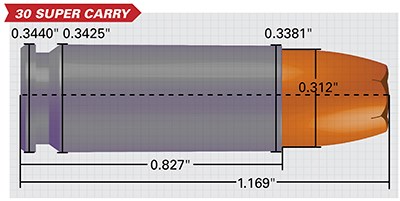 Hitting The “Sweet Spots”
Hitting The “Sweet Spots”
There are “sweet spots” in calibers and terminal ballistics where the velocity, frontal area and sectional density come together in a favorable way to give the required energy and penetration for an intended use. The engineers seem to have found one with 30 Super Carry. Likewise, there are sweet spots in cartridges where the level of power for the intended task and the level of recoil and ease of use in the intended platform merge well. The 30 Super Carry seems well balanced here, too.
The 30 Super Carry cartridges appear to be especially long at first glance, the overall length being quite similar to that of the 9 mm Luger. Although a Super Carry cartridge has more gravitas in casual handling than does a .32 ACP or .380 ACP, its slender diameter is what allows a magazine’s stacked column to accommodate two or more extra rounds. For example, the single-stack Nighthawk 30 Super Carry magazine holds 12 compared to only 10 in the 9 mm version, while the upcoming M&P Shield Plus is expected to likewise boost capacity from 10 to 12 (13 to 15 rounds in the extended magazine). It is conceivable that a full-size, double-stack pistol will gain three or more rounds as such designs hit the market. Additional capacity is typically a strong selling point in a concealed-carry pistol, and for shooters who are interested in the handling qualities of a single-stack design such as the M1911 or the M&P Shield EZ, the 30 Super Carry may increase capacity to where they no longer feel limited. Likewise, a handy micro pistol with 13 to 15 Super Carry rounds on board begins to look like an attractive alternative to a larger compact 9 mm of similar capacity.
Initially, there will be six loads available to shooters in 30 Super Carry: defensive loads from Federal, Speer and Remington (HST, Gold Dot and HTP, respectively) as well as range loads from each closely matching the weight and velocity of their respective jacketed hollow points. The ammunition companies are well aware that the retail prices of each load could affect adoption, and the MSRPs of all six loads are expected to closely track with their .380 ACP product line counterparts.
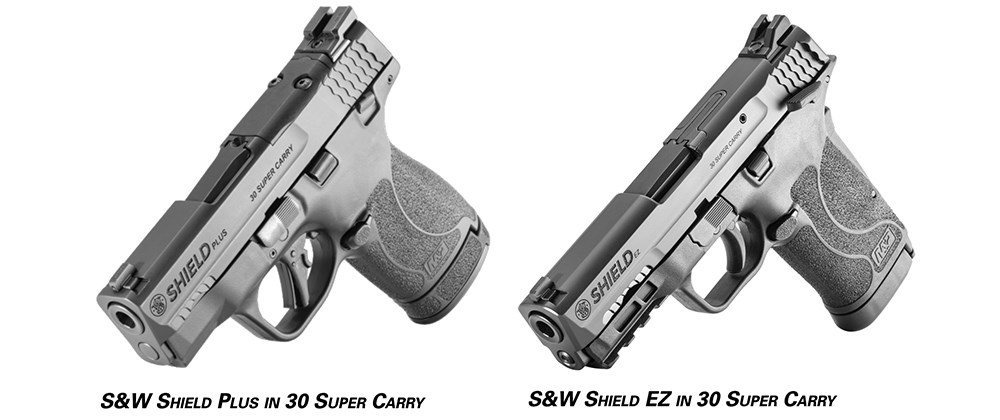
Host Platform & Hopes
As the new 30 Super Carry hits the market, one can expect to see a variety of popular pistols adapted to the new chambering and offered for sale. Smith & Wesson is expected to be the first major maker to market with its pistols, and shooter interest in the new cartridge will play a role in how many other makers adapt their popular pistol designs to accommodate it. In the M&P line, shooters will have a choice of the Shield Plus or the EZ, both very natural platforms for the new cartridge. For those interested in a custom M1911, Nighthawk will offer 30 Super Carry in its President and GRP model lines.
Beyond adapting existing platforms, I suspect that some makers are going to see potential in designing unique pistols specifically around 30 Super Carry. A grip and magazine designed expressly for Super Carry has the potential to be even thinner than a 9 mm Luger design. I’m hopeful that there is room to get .380 ACP-class thinness from a true pocket pistol such as the Glock 42 or Ruger LCP—but with 30 Super Carry performance and capacity.
It will be interesting to see how quickly and fully the public embraces 30 Super Carry. It is clearly a cartridge marketed squarely toward the public, so it cannot take the usual route to broad acceptance via police or military adoption. The concept of getting 9 mm Luger-level performance with additional capacity and less recoil is certainly attractive, but will enough shooters embrace the cartridge to ensure Super Carry earns shelf space in stores? There are a wide variety of variables at play. How available will the pistols be and will the sales force at the local shop be sufficiently knowledgeable and supportive to steer a new shooter toward the 30 Super Carry? Will concealed carriers be confident in the smaller bullet?
I am optimistic for the 30 Super Carry’s success, and I am very much looking forward to getting time with the coming platforms to either confirm or deny my expectations. The cartridge may be arriving during trying times for shooters, but I am thankful that Federal has challenged the status quo and given the market a chance to reconsider what a carry-specific pistol cartridge should be able to achieve.
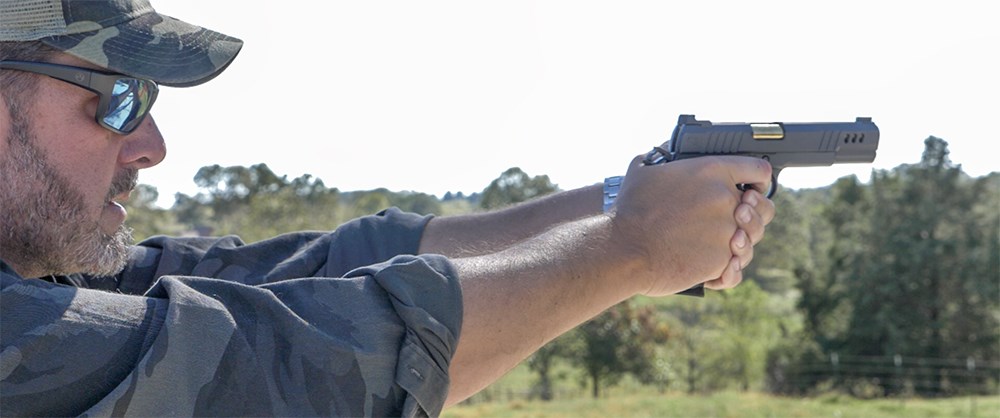
Nighthawk Custom And The 30 Super Carry
Federal partnered with Nighthawk Custom as the 30 Super Carry project took shape to produce the first firing prototype pistols chambered for the new cartridge. Nighthawk’s in-house manufacturing capability allowed it to quickly make the necessary adaptations to chamber its M1911-style pistols for the new cartridge. Nighthawk then worked closely with the Federal engineers as the cartridge evolved from concept to reality. Mark Stone, Nighthawk’s owner, explained that the company fully expects to be able to take the lessons it learned in the rapid modeling and prototyping for Super Carry and apply them to other new projects now in the works.
I traveled to Nighthawk’s Arkansas facility for Federal’s unveiling of the Super Carry cartridge last fall. Nighthawk took a small group of writers behind the scenes in its shop to see how their pistolsmiths build an M1911 and hand-fit, polish, blend and bevel each aspect of the pistol.
I was able to fire the 30 Super Carry M1911 side-by-side with an identically set up 9 mm Luger Nighthawk President Model 1911. A custom-tuned, steel-frame M1911 is about as soft shooting a platform as one could imagine, and Super Carry was exceptionally pleasant and easy to shoot in the pistol.
The Federal team had mentioned that the 30 Super Carry cartridge had displayed great accuracy potential in all of the test loads to date, and that was borne out in our test session. Some of the writers were getting one-hole groups from the bench, and all of us were clearing a steel plate rack with the Super Carry-chambered Nighthawk President at about 50 yards. We backed off to 100 yards just to get a sense of how flat the cartridge was shooting, and I was able to fire a group with the test pistol that I could stretch to cover with a hand. The pistol/cartridge combo certainly seems to have solid accuracy potential.
One thing that struck all of the writers was how odd it felt to have a total of 13 rounds in a single-stack M1911-style pistol. It was a nice upgrade to be at the point where, when shooting an M1911, a fresh magazine is typically required, and then realize that there’s enough ammunition left to run another set of plates.
Article by JUSTIN DYAL


